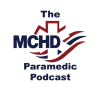There have been multiple recent areas of advancement in prehospital trauma care. The MCHD Paramedic Podcast dives into several of these in a trio of episodes.
TXA
First, in Episode 22, the role of tranexamic acid (TXA) in hypotensive trauma patients is explored.
TXA is a medication that has been used across multiple medical disciplines for decades to assist in bleeding cessation via clot stabilization. Two of the initial trials exploring the use of TXA in trauma, CRASH-2 and MATTERS, are discussed along with the indications and contraindications for TXA use in the prehospital setting.
Simple thoracostomy
In Episode 24, the focus moves from pharmacologic to procedural: the simple thoracostomy. A traumatic cardiac arrest varies from medical cardiac arrest in that the causes are usually not cardiac ischemia or failure.
The approach to traumatic arrest must focus on hemorrhage, high cervical spine injury and obstructive shock. Peripheral access and a fluid challenge along with pelvic binding and long bone reduction are needed to address potential blood loss.
Airway management will correct hypoxia from paralysis due to a high cervical injury. Obstructive shock from major trauma, however, is often a result of tension physiology which must be remedied using thoracic decompression.
Classically, this has been treated in the prehospital arena using needle thoracostomy, but accumulating evidence demonstrates the frequent misplacement and inadequacy of this procedure.
Finger thoracostomy is a skill that is gaining prominence in the EMS setting and MCHD has been a leader in the field. This episode will touch on the training, setup and data behind a simple thoracostomy protocol implementation.
REBOA
Finally, in Episode 58, a history of resuscitative endovascular balloon occlusion of the aorta (REBOA) is broken down from the Korean War to the present day.
REBOA is a percutaneous endovascular technique to occlude the descending aorta in hemorrhagic shock from bleeding below the diaphragm. This allows cerebral perfusion to be maintained while bridging care to the operating room for definitive surgical care.
Due to technological advances, REBOA has moved from the battlefield to the emergency department in certain centers. Learn the background anatomy, the literature basics and future potential of REBOA in this episode.












